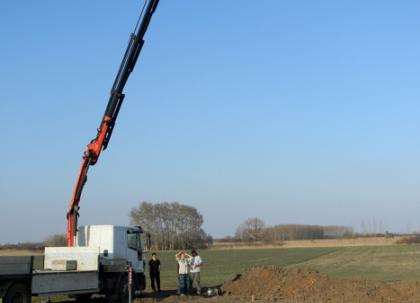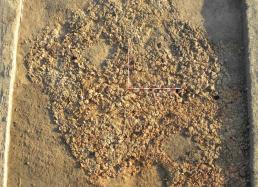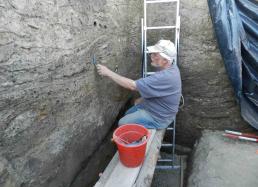3. "Egyszer fent, egyszer lent." (One time up, one time down.)
This week was a series of ups and downs. We spent Saturday afternoon participating in a long-standing Hungarian tradition—making blood-red sausage that's seasoned with garlic and paprika (an "up"). But the warm, summery weather we had last week gave way to cooler weather with lots of cold, bitter wind that kicks up the dust and makes it difficult to work (a "down"). It’s exhausting! On the other hand, the rain we were expecting early in the week never reached us, and we got another full week of work in at the site (another "up").
At the end of last week we hired a crane (a cherry picker) to come out to the site so we could get good aerial photos of the longhouses we’re excavating in the north (Block N1B1) and southeast (Block SE1B1) parts of the site (way "up"). But on Sunday we learned of the untimely passing of the previous Mayor of Vésztő, Mr. János Kaszai (way "down"), who was a good friend to the project and to us personally.
The story about the cherry picker is typical of how our project has evolved over the years. Frequently, Attila and I are in the car talking about how to work more efficiently. One time, in 2000, we were lamenting how difficult it was to remove the plowzone from the surface by hand—it’s thick, heavy, clay. This is less of an issue when we’re excavating small test units, but when we open big surfaces—for example the 10x10-m blocks we opened this year—it can take weeks!
So we were driving through the town of Békés while we were tossing around ideas and there, at the side of the road, we saw a small front loader (called a Bobcat). I said to Attila, “That’s what we need!” and he replied, “I know a guy!” The next day, we had a Bobcat with a toothless bucket on the site, carefully removing the disturbed plowzone.
Another time, we were trying to figure out how to get aerial photos of the Copper Age longhouses we were excavating. Attila said, “I know a guy!” and the next day I found myself and my camera going up in a 1970s Soviet helicopter that had been retrofitted for crop dusting.
This time, we were getting frustrated with our extension ladders because they couldn’t reach high enough to give us a good overhead view of the longhouses. We decided we should get a crane to lift us above the excavation blocks. Attila, of course, “knew a guy,” and the next day we were going up (way up) in the cherry picker, camera in hand, to get overviews of the longhouses.
To report on the progress of our other team members, during the course of the week, Paul Duffy and his team completed the intensive collection of surface artifacts at the site (almost 3,596 collection units), which now covers about 60 hectares and extends even further to the west and the southwest. Unfortunately, those areas are not plowed, and we’ll have to use other techniques to explore them—geophysics and small shovel tests.
Paul’s team then moved to the test excavation in the west (Block W1B1), where they’re nearly done excavating a small test block (2x3 m) that seems to verify our impression that the western part of the site was more intensively used than the outlying longhouse clusters, but perhaps not as much as the southern area we excavated last year (Block S1B1).
Next, Julia Giblin and her team have been working through the heavy clay in the southeast area to expose the longhouse there. It’s slow going and very confusing because the dark clay makes it difficult to identify different sediments, but we feel like we’re starting to get down to a level where we’ll be able to clarify the extent of the longhouse and its construction.
Julia leaves on Saturday because she’s teaching a course this term before she starts her job at Quinnipiac University in the fall. She started as an undergraduate on our project in 2003 and now has a Ph.D. and a tenure-track job. We’re very proud of Julia, and we’re sad to see her go!
In the northern longhouse (Block N1B1) the Hungarian team is beginning to remove the wall rubble to expose the clay floor of the house. One 2x2-m unit produced 250 kilos of daub! In some areas, we’ve identified what appear to be the remains—and in some cases, impressions—of planks or square posts that were part of the wall structure of the house. These are important not only for letting us understand how houses were built on this site and how they related to those built elsewhere in the region, but also because they'll yield good samples for radiocarbon dating.
At the tell, the work is well underway, and Rick Yerkes and his team are mapping the complicated profiles from the 1968 trenches excavated by Kornél Bakay.
Sadly, the adrenaline rush of this intensive season was interrupted by the news of János Kaszai’s death last weekend. We first met János when we began living and working in Vésztő in 2000. He was elected to the office of Mayor five times and only recently chose not to stand for reelection because his health was starting to falter.
Throughout his tenure as Mayor, he bent over backwards to help facilitate our work here. Over the years, we became friends, so it was with sad hearts that we carried a wreath to his funeral yesterday and listened to stories about all the other people he helped here in Vésztő. Even when his health was failing, he exuded an energetic kindness and honest inquisitiveness that we'll never forget.
Tomorrow morning, we leave for a conference in Budapest where we’ll present a paper about our current research. On Sunday we'll pick up the Greek geophysical team, as well as our sixth 4x4 vehicle. It’s supposed to rain this weekend, so we hope it will clear up by Monday and allow us to get back to work. We've got only two more weeks on the site and lots more to do!
Stay tuned,
Bill






